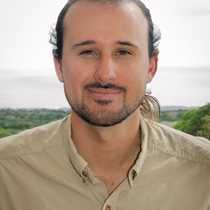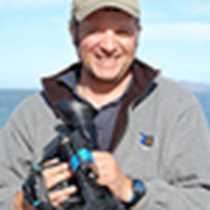As first light appeared on the eastern sky, National Geographic Islander’s Captain Pablo Garces lined the ship up with the lights that mark the safe route through the narrow, deep water channel that leads into Darwin Bay.
Naturalist Fabian Bucheli led our last kayaking outing of the expedition as soon as we had set anchor. The kayakers then returned to the ship for a well-deserved breakfast together with the rest of the guests.
Right after breakfast we left for our first landing of the day. A wet landing at a narrow white sand beach littered with many small coral fragments. We didn’t have to wait until landfall to realize that Genovesa Island is a “birdwatchers paradise”. As we rode the short distance from our ship to the shore, hundreds if not thousands of birds followed the cliff edge that makes up the coast line of the massive natural harbor. We watched boobies, gulls and red billed tropic birds hang-gliding while Great frigate birds glided in a tight circle in several places as if a giant invisible tornado was sucking them up into the sky. Before returning to our floating home we had a chance to see many of the different seabird species that call Genovesa Island their temporary home while nesting and tending to their chicks.
By mid-morning we returned to our ship and got ready for yet another excursion, this time it was for our last opportunity to snorkel. Even though the visibility was not quite as good as we had been lucky to have the previous day at Sombrero Chino, it turned out to be better than average. Here we had a chance to see a few new species of tropical fish like the Moorish idol and the Gold rimmed surgeon fish.
After lunch our younger explorers took advantage of an opportunity to learn to drive a Zodiac and afterwards they returned the ship to get ready for our last excursion of this expedition.
Late in the afternoon we had a dry landing in an area known as the Prince Phillip Steps where we hoped to catch a glimpse of short eared owls. They have adapted to hunt for nesting Storm petrels and other small birds during the day in the absence of other day-active birds of prey like the Galapagos hawk, which is thought to never have inhabited this remote island to the north-eastern end of the archipelago.
We returned to our floating home with last light feeling a slight sense of accomplishment after having spotted the small owl and many Nazca and red-footed boobies and great frigate birds with chicks.
As if our day had not been amazing enough, expedition leader Lynn Fowler invited everybody on deck at last light. She had just realized that today there were perfect conditions to see five planets (Venus, Mercury, Jupiter, Saturn and Mars) perfectly aligned. As I write these last lines I get ready to go once again up to the sundeck hoping to catch a glimpse of the forecasted meteor shower!









